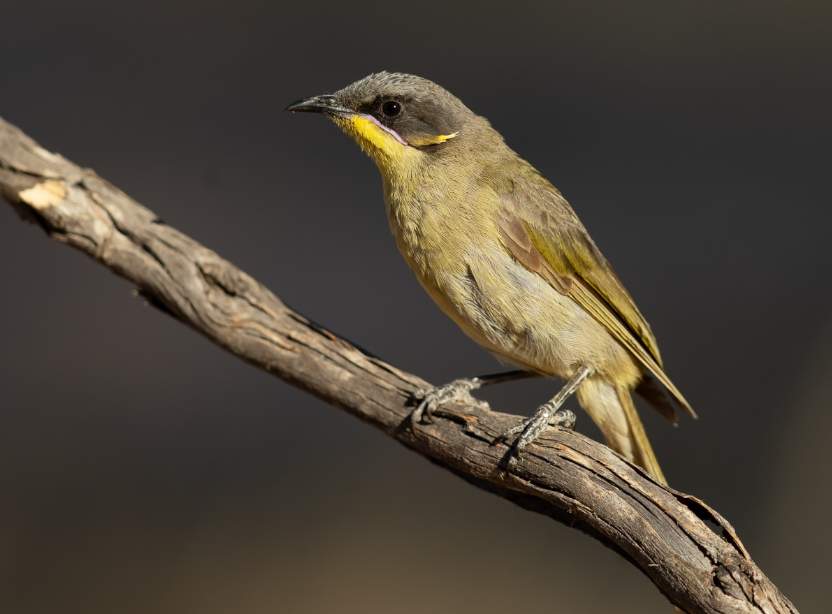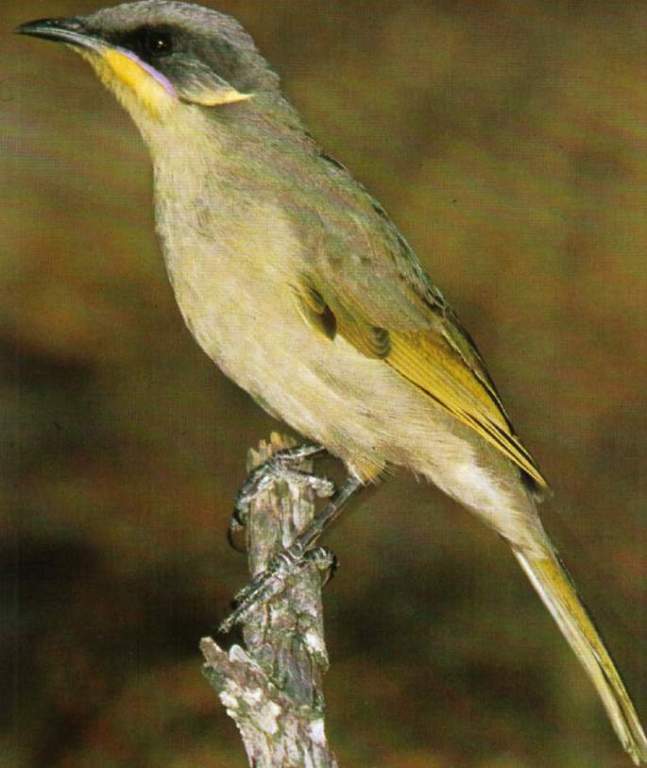Habitat: The purple-gaped honeyeater (Lichenostomus cratitius) is confined to stands of dense, short, elongated mallee and its fringing heaths around the southern Australian coast and near the inland. There it is sedentary, moving only locally to flowering flushes and only then gathering in loose aggregations of up to five or six birds.
The purple-gaped honeyeater is confined to stands of dense, whipstick-shaped mallee and its fringing heaths around the southern Australian coast and near-inland. There it is sedentary, moving only locally to flowering flushes and only then gathering in loose aggregations of up to five or six birds. A quiet, unobtrusive bird, except in spring, when they call frequently. In warmer climates, they drink and bathe regularly. They often chase other birds, particularly when feeding, and are aggressive towards other honeyeaters.

Identification: Both sexes are similar; the males are larger. The upper parts are plain olive-green, washed grayer on the crown, and citrine on the wings and tail. Dusky black sash from lores over ears, ending in an acute yellow ear plume; bare lilac flange from gape down cheeks; malar line yellow. The underparts of this bird are plain yellow-grey. The eyes are brown. The bill is black. The feet are dark gray. The immature (as an adult) is dull; the gape flange is pale yellow.
Diet: Insects and nectar are the primary food sources; however, birds also catch flying insects on the wings or under loose bark on tree trunks and branches. Scale insect seeds, pollen, and honeydew are not consumed.
Vocalizations: Purple-gaped Honeyeaters chirp sharply and twitch in contact. Also clicks and whistles. A harsh chatter of rapid repetitions of chuk-chuk-chuk-chuk-chuk-chuk-chuk-chuk is used to mark territory in the song.
Nesting and breeding: Nesting and breeding occur in July–December. Nest in a cup of bark strips and grass bound with cobwebs, lined with soft fiber, and slung from the rim in dense foliage below 2 meters up.
Eggs: Purple-gaped The honeyeater lays two eggs, pink with sparse red-brown spotting, more at the larger end; they are oval, about 21 x 15 mm.
Distribution: Purple-gaped honeyeaters are found in whipstick Mallee thickets around the south coast and sub-coast of the mainland, in pockets east of Bendigo, Victoria.
Alternative Names: This bird is also known as the lilac-wattled honeyeater and the wattled-cheeked honeyeater.
Size: A purple-gaped honeyeater is about 160–170 mm long.
Races: There are two races.
Read More: Singing honeyeater (Gavicalis virescens)







